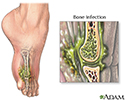Osteomyelitis - discharge
Bone infection - discharge
When You're in the Hospital
You have osteomyelitis , a bone infection caused by bacteria or other germs. You may have been in the hospital to treat a broken bone or to have other surgery on your bones. Your surgeon may also have removed some infection from your bones or drained an abscess.
Osteomyelitis
Osteomyelitis is a bone infection. It is mainly caused by bacteria or other germs.

What to Expect at Home
Your doctor will ask you to take medicines called antibiotics at home to kill the infection in your bone. At first, you will probably need antibiotics given into a vein in your arm, chest, or neck. At some point, your doctor may switch you to antibiotic pills.
While you are on antibiotics, your health care provider may check your blood for signs of toxicity from the medicine.
You probably need to take this medicine for at least 3 to 6 weeks. Sometimes, you will need to take it for several months.
Self-care
If you are getting antibiotics through a vein in your arm, chest, or neck :
Vein in your arm, chest, or neck
Home intravenous antibiotic therapy; Central venous catheter - home; Peripheral venous catheter - home; Port - home; PICC line - home; Infusion thera...
- A nurse may come to your home to show you how, or to give you the medicine.
- You will need to learn how to care for the catheter that is inserted into the vein.
- You may go to your doctor's office or a special clinic to receive the medicine.
You may need to store some of the medicine at home. Be sure to do it the way your provider told you to.
You must learn how to keep the area where your IV is clean and dry. You also need to watch for signs of infection (such as redness, swelling, fever, or chills).
Make sure you give yourself the medicine at the right time. DO NOT stop taking antibiotics even when you begin to feel better. If you do not take all of your medicine, or take it at the wrong time, the germs may become harder to treat. The infection may come back.
If you had surgery on your bone, you may need to wear a splint, brace, or sling to protect your bone. Your provider will tell you whether you can walk on your leg or use your arm. Follow what your provider says you can and can't do. If you do too much before the infection is gone, your bones may get injured.
If you have diabetes, it is very important to keep your blood sugar under control .
Keep your blood sugar under control
Hyperglycemia - control; Hypoglycemia - control; Diabetes - blood sugar control; Blood glucose - managing

When to Call the Doctor
Call your provider if:
- You have a fever of 100.5°F (38.0°C), or higher, or have chills.
- You are feeling more tired or ill.
- The area over your bone is redder or more swollen.
- You have a new skin ulcer or one that is getting bigger.
- You have more pain around the bone where the infection is located, or you can no longer put weight on a leg or foot or use your arm or hand.
References
Berbari EF, Steckelberg JM, Osmon DR. Osteomyelitis. In: Bennett JE, Dolin R, Blaser MJ, eds. Mandell, Douglas, and Bennett's Principles and Practice of Infectious Diseases . 8th ed. Philadelphia, PA: Elsevier Saunders; 2015:chap 106.
Dabov GD. Osteomyelitis. In: Canale ST, Beaty JH, eds. Campbell's Operative Orthopaedics . 12th ed. Philadelphia, PA: Elsevier Mosby; 2013:chap 21.
-
Osteomyelitis - illustration
Osteomyelitis is infection in the bones. Often, the original site of infection is elsewhere in the body, and spreads to the bone by the blood. Bacteria or fungus may sometimes be responsible for osteomyelitis.
Osteomyelitis
illustration
Review Date: 7/31/2016
Reviewed By: Jatin M. Vyas, MD, PhD, Assistant Professor in Medicine, Harvard Medical School; Assistant in Medicine, Division of Infectious Disease, Department of Medicine, Massachusetts General Hospital, Boston, MA. Also reviewed by David Zieve, MD, MHA, Isla Ogilvie, PhD, and the A.D.A.M. Editorial team.

